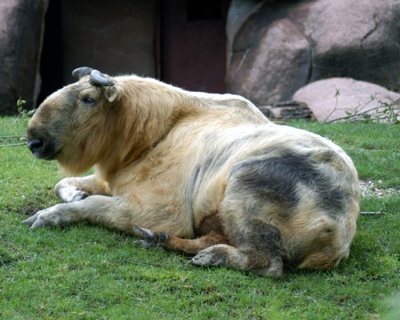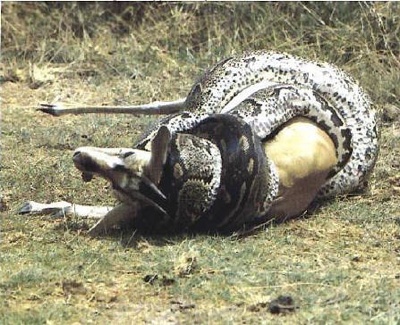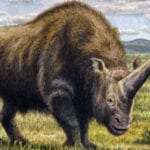 Travel
Travel  Travel
Travel  Creepy
Creepy 10 Haunted Places in Alabama
 History
History Top 10 Tragic Facts about England’s 9 Days Queen
 Food
Food 10 Weird Foods Inspired by Your Favorite Movies
 Religion
Religion 10 Mind-Blowing Claims and Messages Hidden in the Bible Code
 Facts
Facts 10 Things You Never Knew about the History of Gambling
 Weird Stuff
Weird Stuff 10 Cool and Creepy Facts about Collecting Tears
 Humans
Humans The Ten Most Lethal Gunslingers of the Old West
 Misconceptions
Misconceptions 10 Phony Myths and Urban Legends That Just Won’t Die
 History
History 10 Amazing Roman Epitaphs
 Travel
Travel Top 10 Religious Architectural Marvels
 Creepy
Creepy 10 Haunted Places in Alabama
 History
History Top 10 Tragic Facts about England’s 9 Days Queen
Who's Behind Listverse?

Jamie Frater
Head Editor
Jamie founded Listverse due to an insatiable desire to share fascinating, obscure, and bizarre facts. He has been a guest speaker on numerous national radio and television stations and is a five time published author.
More About Us Food
Food 10 Weird Foods Inspired by Your Favorite Movies
 Religion
Religion 10 Mind-Blowing Claims and Messages Hidden in the Bible Code
 Facts
Facts 10 Things You Never Knew about the History of Gambling
 Weird Stuff
Weird Stuff 10 Cool and Creepy Facts about Collecting Tears
 Humans
Humans The Ten Most Lethal Gunslingers of the Old West
 Misconceptions
Misconceptions 10 Phony Myths and Urban Legends That Just Won’t Die
 History
History 10 Amazing Roman Epitaphs
10 Beasts That Used To Be Mythical
This list is about animals that were once thought to be mere legends, but were eventually confirmed to be real. Today, many of these “mythical beasts” are so well known that we couldn’t imagine a zoo without them!
As famous as gorillas are today, there was a time in which they were no more tan a myth. Explorers would return from African jungles and tell stories about hairy, giant man-beasts of terrible strength and temper, with a nasty habit of abducting and raping women! Such stories were dismissed by scientists as nonsense, and as a result, the gorilla was unknown to science until quite recently. It is believed that the first gorilla report comes from Greek explorer Hanno, from the 5th century BC. Hanno traveled to the western coasts of Africa, possibly to Sierra Leona or even the gulf of Guinea, and reported “an island filled with savage people, most of them women, and covered on hair. Our interpreters call them gorillae”.
Maybe we should mention that not everyone is convinced about Hanno having encountered actual gorillas (his gorillae could have been chimpanzees). Much later, in 1625, British explorer Andrew Batell reported seeing a “monster” covered on hair except for the face and hands, which slept in trees and fed on fruit. According to him, this “monster” was most similar to a man, but “with the stature of a giant”. Gorillas remained obscure and poorly understood for many more years, being often thought of as brutish, unintelligent and extremely violent. It wasn’t until 1847 that a westerner (physician Thomas Savage) managed to obtain several gorilla bones, including a skull, while in Liberia, and published the very first formal description of the great ape. The next decade, explorer Paul du Chaillu became the first modern European to see a live gorilla during his expeditions to equatorial Africa. As for the mountain gorilla, a different, larger species, it was believed to be a myth until 1902!
I have already talked about the Okapi, but it would be wrong to leave it out of this list. The Okapi was well known to the Ancient Egyptians (although it was not native to Egypt) and of course, to the pygmies who lived in the same central African forests. Europeans, however, didn’t believe the pygmies’ stories; they considered the okapi to be a mythical creature, and even called it “The African Unicorn”! In 1890, Henry Stanley explored the jungles of the Congo and he became interested in a native word, “okapi” (which he misheard and wrote as “atti”). The pygmies used the word both for the non-native domestic horse, and for another, large animal they occasionally caught and ate.
A certain Sir Henry Johnston, who was to become the governor of Uganda, read Stanley’s book and became obsessed over the strange creature. He managed to find tracks from the animal as well as pieces of striped skin, which according to the pygmies, belonged to the mysterious okapi. Johnston sent the skin to London, where scientists, for the first time, took interest in the beast and hypothesized about its identity. Was it an unknown species of jungle zebra? Or maybe a late surviving, prehistoric Hipparion proto-horse? Since they didn’t have a better specimen, they named the animal Equus johnstoni, tentatively assuming that it was a member of the horse and zebra genus.
In 1901, finally, Johnston managed to get an entire skin, and a skull. He sent them to London and scientists were utterly surprised. The animal was incredibly similar to some fossilized remains of an ancient giraffe relative, found in 1838 in Greece! The mystery was solved; the mysterious African unicorn did exist, but it wasn’t a zebra or horse, but the last and only living relative to the giraffe!
Today, these mostly vegetarian, black and white bears are among the most famous animals in the world (what scientists call “charismatic megafauna”). However, they were practically unknown for centuries, even in China! Indeed, although Chinese artists have constantly depicted black bears and bamboo forests since ancient times, the giant panda was never depicted until the 20th century! Rumors and reports of a strange “white bear” found in Chinese mountains were regarded as myths until 1869, when French missionary Armand David sent the skin of a hunted specimen to Europe. It was only then that pandas were finally accepted by scientists as a real animal.
Giant pandas were finally seen alive by a European in 1916, when German zoologist Hugo Weigold got to see and buy a cub. (Don’t get excited, they don’t sell baby pandas anymore). As an interesting side note, giant pandas are known in China as the Great Bear-Cat; this is because pandas have vertical pupils, just like cats, but unlike other bears. They were once thought to be giant, aberrant relatives to the raccoon, but DNA testing has proved what seemed obvious from the beginning; that they are a true, if unusual member of the bear family.
Yep, the uber-famous giraffe was once a mythical animal. We have to admit that, if we didn’t know giraffes and someone showed us a picture of one, we would have trouble to believe its existence. Just take a look at them! They ARE weird looking animals. Giraffes were relatively familiar to the Ancient Egyptians, even though they were not native to Egypt (pharaoh Ramses II is said to have kept a giraffe, among other exotic pets, in his private zoo). The Greek, on the other hand, thought of the giraffe as a legendary beast, the camelopard, which was said to be the result of the mating of a camel and a leopard! Even today, the giraffe’s scientific name (Giraffa camelopardalis) pays tribute to this legend.
The Roman were more used to the giraffe after some of them were captured and sent to Rome both as exotic pets for the Emperor and as an exhibition in the Circus Maximus. After this, however, no more giraffes were known in Europe until 1486, when a live specimen was given to Lorenzo de Medici in Florence. It is also known that when the Chinese first saw a giraffe in 1414, they thought it was a Qilin, a legendary beast of Chinese mythology, and even today, the word kirin is used for the giraffe in several Asian countries. (Interesting side note: giraffes did exist in Asia and even in Europe in prehistoric times!).
In the well known Greek myth of Jason and the Argonauts, Jason is sent by his evil uncle Pelias into a suicidal mission; to get hold of the Golden Fleece. This was the fleece of a semi-divine ram named Chrysomallus, who had been sired by Poseidon himself. Some experts believe that the legend of the Golden Fleece was inspired by the golden coat of a real animal, today known as Golden Takin. This animal is found in the Himalaya. Although described by western scientists in 1850, the Takin has always been somewhat of a legend; in Bhutan, its origins are said to be supernatural. It is said that in the 15th century, a powerful and wise Lama visited the country and was urged by his followers to perform a miracle.
Eventually the Lama accepted, and told them to bring him a whole goat and a whole cow. People did as he asked, and the Lama, much to the amazement of everyone, ate all the meat of the goat and cow leaving only bones! But this was not the real miracle. Once he finished his unlikely meal, the Lama took parts of the cow and the goat and pieced them together, forming a new animal. Then, with a snap of his fingers, he gave it life. The strange resulting animal was the Takin. Due to this interesting legend, the Takin is a most revered creature in Bhutan, and is considered the national animal in said country.
Today we tend to imagine dragons as being rather dinosaur-like, but early historians actually described them as being huge serpents that killed their prey by coiling around them and “crushing them to death”. Isidore de Seville said that the “dragon” was the largest kind of serpent, while Pliny the Elder described colossal battles between the constricting dragon and the elephant. According to him, the dragon would coil around the elephant and strangle it, but then the elephant would fall to the ground, vanquished, and crush the dragon under its weight. He also mentioned that dragons were found in Ethiopia, but that that the largest ones were found in India.
In the 8th century AD, St. John of Damascus said “I am not telling you, after all, that there are no dragons; dragons exist, but they are serpents born from other serpents. When just born and young, they are small, but then they grow up and mature, they become so big and fat that they exceed other serpents in length and size. It is said that they grow up to thirty cubits or more, and become as thick as a huge log”. This all sounds like an obvious description of python snakes, which do kill prey by constriction, are the largest snakes in the Old World (growing up to 8 or 9 meters, sometimes more!), and do live in Ethiopia and India. In other words… pythons and dragons are one and the same! Even the name Python is borrowed from an ancient dragon from Greek mythology, so big and powerful that only the sun god Apollo could defeat her. Although occasionally some pythons were captured and sent for exhibition to Rome in ancient times, they held their mythical status for a long time.
One of the most famous mythical sea monsters is the Kraken. Legends of this formidable denizen of the sea, armed with powerful tentacles and strong enough to sink a ship, were told in Norway and Iceland and according to modern scientists, were based on sightings of the giant squid (Architeuthis). Since the giant squid prefers to live in abyssal waters, it is almost never seen alive by humans; even so, dead specimens are sometimes washed ashore, and so the existence of the creature has been reported since ancient times; Pliny the Elder mentioned them in his treaty on Natural History, and said that they could grow up to 9.1 meters long (now we know they get bigger!).
As well as the legend of the Kraken, the giant squid may have inspired other classic myths, including the Greek Scylla, a multi-headed monster that snatched men from their ships and devoured them, and even the “sea serpents” that strangled Laocoön and his sons in the Iliad. But even though giant squids were reported by Aristotle and Pliny the Elder, they were so fantastic that even later scientists still had trouble to believe in their existence; in 1861, the crew of the Alecton dispatch steamer had a close encounter with a giant squid, and even managed to get hold of a piece of the animal’s tail. However, they were ridiculed by scientists, who told them that such a creature was “against the laws of nature”! Even today, the giant squid maintains its semi-legendary status. We all know it exists, but it has been called “the most elusive image in Natural History”. It was only in 2004 that the giant squid was finally photographed in its natural habitat; the first video was taken two years later.
It is said sometimes that Komodo dragons were discovered by a downed pilot from WWI who swam to a remote island in Indonesia and reported seeing giant reptiles in the island’s coasts. Unfortunately, no one believed him. Other versions say that the dragons had already been reported before, and that eventually, the rumors of “land crocodiles” and “prehistoric monsters” roaming Komodo and the nearby islands became too persistent to be ignored; in 1910, a Dutch lieutenant decided to go to the island and get evidence of the creature’s existence. He succeeded, and sent a photo and the skin of a gigantic lizard to Bogor, Java, where the director of the Zoological Museum described it formally for the first time.
Later, in 1926, a much publicized expedition to Komodo resulted in the capture of two live specimens; this expedition inspired one of the most famous movies of all times, King Kong, which was also about prehistoric animals found in a remote island. The movie’s director even wanted to have Komodo dragons in the movie! But this was ultimately not possible and he replaced them with animated dinosaurs. Komodo dragons are the world’s largest lizards. One modern day myth about them is that they lack venom, and that their victims die of blood poisoning thanks to the deadly bacteria in the dragon’s mouth. Although it is true that dragons have plenty of dangerous bacteria on their saliva, recent studies have suggested that they are also able to produce powerful, hemorrhage and paralysis-inducing venom, making them the largest venomous animals alive.
The Ziphius or “Sea Owl” was a legendary sea monster, described in medieval times, which was said to have huge eyes and a beak-like mouth, hence its name. The creature was described as being of enormous size and able to destroy a ship if enraged, although, fortunately, it was also extremely difficult to see. Today, scientists believe that the inspiration for this myth were the little known beaked whales. These mysterious cetaceans look like giant dolphins but are not related closely to them; they live in deer waters and are rarely seen in the surface (although they of course need to breathe air as do all whales). Most of what we know about them comes from dead specimens washed ashore.
Some species are only known from carcasses or even bones found in some remote beach! As a tribute to the mythical creature, one species of beaked whale is called Ziphius by scientists. Beaked whales deserve the second place in this list because they were mythical creatures in the past, and they are semi-mythical even today. Scientists would give anything to know more about these huge creatures, but the “Sea Owl” doesn’t seem willing to reveal its secrets just yet.
The tiger is one of the best known animals in the world, but this was not always the case. To the ancient Greek, the tiger was a legendary animal, known as the manticore (from Persian martya, “man”, and xwar, “comer”), and described in “Indika”, a treaty by a certain Ctesias about India, which used to be popular among Greek naturalists and historians but is sadly lost today. According to Pausanias in his “Description of Greece”: “The beast described by Ctesias in his Indian history, which he says is called mantichoras by the Indians and man-eater by the Greek, I am inclined to believe is the tiger. But that it has three rows of teeth along each jaw and spikes at the tip of its tail with which it defends itself at close quarters, while it hurls them like an archer’s arrows at more distant enemies; all this is, I think, a false story that the Indians pass on from one to another owing to their excessive dread of the beast”.
It makes sense for the tiger to be the inspiration for the manticore. The latter was said to live in India and south eastern Asia (the tiger’s main range), and to be lion-like in size and appearance, but with reddish fur. It was also said to have the tail of a scorpion, which could have been inspired by the black rings and black tip in the tiger’s tail. And it was reported to be so fierce that it would snatch adult men from villages and drag them into the jungle, after which they were never seen again. Same was often the case with the great cat.
Even though tigers were often seen in the circus in Ancient Rome, they weren’t seen in Europe for a long time after the Empire’s fall, and they once again became a legend. Fantastic stories about them were told in medieval bestiaries; in some of them, hunters would steal tiger cubs and when the adult tiger chased them, they would throw a mirror or a crystal ball and the tiger would either stop to admire its own reflection, or mistake it for its cub and abandon the chase.
It was also famous for its speed; the name tigris itself, from which “tiger” derives, is actually the ancient Persian word for arrow!


















